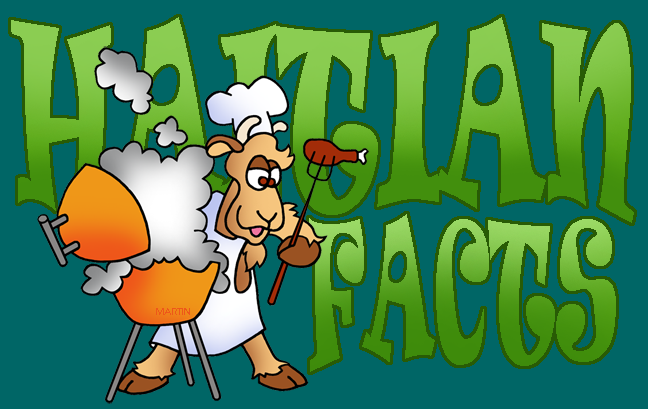Fun Facts about Haiti
In 1492, after sailing the ocean blue,
Christopher Columbus "discovered" the island we call "Hispanola".
One third of the island is Haiti, and the other two thirds is the
Dominican Republic. Of course, Columbus thought he was looking at
India, and the people living there had no need to be discovered.
When the Spaniards arrived on the island, they found the local people roasting animal meat on a metal framework called a "barbacoa". It isn't hard to see how that word gradually changed to "barbecue". That same metal framework was used for protection from animals when the people slept. Hopefully, they let the metal first cool down.
Among the pre-Columbian people living in Haiti were the Amerindians called the Taíno. Their name for their homeland was "Ayiti", meaning "Land of Mountains". This name evolved into the current name of the country, Haiti.
In the 1700's, Haiti was the richest colony in the French Empire. It was called the "Pearl of the Antilles". Unfortunately, today Haiti is the poorest country and one of the most densely populated in the Western Hemisphere. Most Haitians live on less that two dollars a day.
Founded in 1749, the capital city of Haiti is Port-au-Prince. That translates from French into "port of the Prince". The Prince was a ship anchored in the bay.
The Spanish (and disease they brought with them) killed off the island's original inhabitants in just a few decades. Slaves from Africa were brought to the island to help French colonists with forestry and sugar production. In 1801, Toussaint L'Overture, a former slave, led nearly half a million slaves in a revolt against their colonial slave owners. The revolt was successful, and Haiti became the world's first black republic and the first independent country in Latin America. Most of Haiti's current citizens (95%) are descendants of African slaves.
The official languages of Haiti are French and Haitian Creole.
Haiti's national sport is soccer, but a traditional favorite sport is rooster fighting.
The main industries in Haiti are sugar, flour milling, coffee, textiles, and cement. Most people outside the urban centers rely on subsistence farming.
A main staple in the Haitian diet is rice and beans. Haitian cooking includes a lot of spicy hot peppers. How much fire you put in your mouth is a personal preference. Just be warned before you first taste pikliz. It looks like coleslaw, but looks can be deceiving.
Haitian artists are extremely talented in making crafts from recycled materials. They make incredible things from soda cans, potato chip sacks, scraps of metal, seeds, clay, glass, and paper maché.
On January 12, 2010, much of Haiti was devastated by a 7.0 magnitude earthquake. More than 200,000 people were killed. One million people were left homeless, still living in overpopulated tent cities. It is estimated that it will take decades for the country to recover.
When the Spaniards arrived on the island, they found the local people roasting animal meat on a metal framework called a "barbacoa". It isn't hard to see how that word gradually changed to "barbecue". That same metal framework was used for protection from animals when the people slept. Hopefully, they let the metal first cool down.
Among the pre-Columbian people living in Haiti were the Amerindians called the Taíno. Their name for their homeland was "Ayiti", meaning "Land of Mountains". This name evolved into the current name of the country, Haiti.
In the 1700's, Haiti was the richest colony in the French Empire. It was called the "Pearl of the Antilles". Unfortunately, today Haiti is the poorest country and one of the most densely populated in the Western Hemisphere. Most Haitians live on less that two dollars a day.
Founded in 1749, the capital city of Haiti is Port-au-Prince. That translates from French into "port of the Prince". The Prince was a ship anchored in the bay.
The Spanish (and disease they brought with them) killed off the island's original inhabitants in just a few decades. Slaves from Africa were brought to the island to help French colonists with forestry and sugar production. In 1801, Toussaint L'Overture, a former slave, led nearly half a million slaves in a revolt against their colonial slave owners. The revolt was successful, and Haiti became the world's first black republic and the first independent country in Latin America. Most of Haiti's current citizens (95%) are descendants of African slaves.
The official languages of Haiti are French and Haitian Creole.
Haiti's national sport is soccer, but a traditional favorite sport is rooster fighting.
The main industries in Haiti are sugar, flour milling, coffee, textiles, and cement. Most people outside the urban centers rely on subsistence farming.
A main staple in the Haitian diet is rice and beans. Haitian cooking includes a lot of spicy hot peppers. How much fire you put in your mouth is a personal preference. Just be warned before you first taste pikliz. It looks like coleslaw, but looks can be deceiving.
Haitian artists are extremely talented in making crafts from recycled materials. They make incredible things from soda cans, potato chip sacks, scraps of metal, seeds, clay, glass, and paper maché.
On January 12, 2010, much of Haiti was devastated by a 7.0 magnitude earthquake. More than 200,000 people were killed. One million people were left homeless, still living in overpopulated tent cities. It is estimated that it will take decades for the country to recover.
